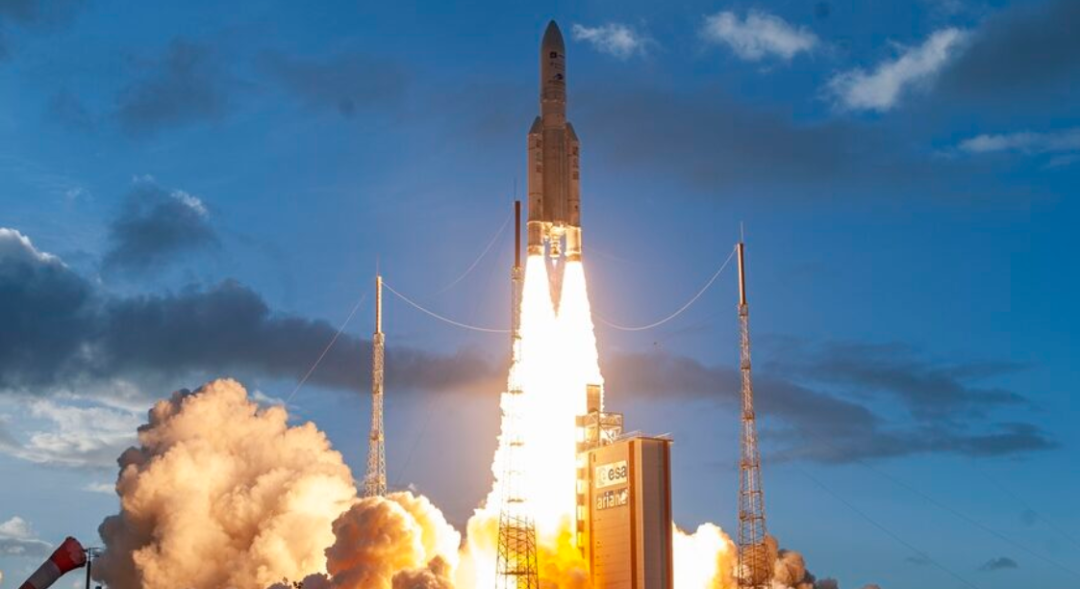After being grounded for nearly a year, Ariane 5 resumes launch
After being grounded for nearly a year, Ariane 5 resumes launch
The following article is from Hang Xiaoyu
On July 30th, the Ariane 5ECA+carrier rocket of Ariane Space Corporation carried out a one rocket, two satellite launch mission in Kourou, French Guiana, sending the "Star-1" D2 of Brazilian telecommunications company Star-1 (a wholly-owned subsidiary of Cralo) and the "European Communication Satellite Quantum" satellite of European Communication Satellite Company into orbit. The rocket ignited and took off at 18:00 local time (5:00 Beijing time on July 31st). The satellite deployment will be completed in about 36 minutes.

This is the first launch of Ariane 5 since August 15th last year. Ariane stated in May this year that the separation of the fairing of the rocket was "not very normal" during two launches last year. Industry sources reported in May that during those two launches, the separation system caused unacceptable vibrations to the payload, but did not cause any damage to the payload. The analysis and rectification work regarding this issue has led to the rocket being effectively grounded. According to the current schedule, Ariane 5 will conduct another commercial satellite launch around the end of September, followed by the highly anticipated James Webb Space Telescope launch mission.
The "Star One" D2 is built by Maxard using the SSL-1300 series platform, with a launch weight of 6190 kilograms, equipped with commercial C, Ku, and Ka band capacity, and a military X-band payload. It will be deployed to the 70 degree west longitude orbit to provide communication, live television, and high-speed broadband services to users in South America, Mexico, Central America, and parts of the Western Ocean. The design life is over 15 years.
The "European Communication Satellite Quantum" was built by Airbus Defense and Space and Surrey Satellite Technologies under a public-private partnership research and development project between the European Space Agency, Europa, and Airbus. Airbus served as the main contractor and used Surrey's innovative GMP-TL platform, covering the Middle East and North Africa. It is mainly aimed at government customers and has a launch weight of approximately 3461 kilograms. The satellite is equipped with a payload that can be reprogrammed to change its configuration in orbit, enabling it to change its coverage area, bandwidth, power, and frequency in orbit and effectively use it at any orbital position. It is referred to as a "chameleon" by the European Space Agency. The satellite is equipped with a Ku band electronically scanned multibeam antenna, built by Airbus in Spain. It can generate 8 Ku band beams and eliminate interference signals by locating the interference source. The satellite utilizes technology developed under the European Space Agency's Advanced Telecommunications Systems (ARTES) program and is supported by the British Space Agency. The satellite platform consists of a 2.5-meter-high composite material center load-bearing cylinder (equipped with a dual element propellant chemical propulsion system) and newly developed static earth orbit momentum wheels and gyroscopes.
58彩票 Eutelsat announced at the end of July 2020 that the International Telecommunications Satellite Company had agreed to help promote half of the capacity of the "Eutelsat Quantum". These two operators stated that they have agreed to allow the satellite to adopt a 48 degree east longitude orbit shared by both parties. Eutelsat, as the government sales department of the International Telecommunication Satellite Company, will promote onboard capacity to the US military, and the security of the promoted capacity will be upgraded, such as implementing "protected payload management" measures.
The European Communication Satellite Quantum is a leader in programmable satellites, claiming to be the first programmable Ku band commercial communication satellite, although manufacturing delays have reduced its lead. The star was once planned to be launched in 2018. Competitors SES and Weixun of Ouweitong also have their own reconfigurable satellites scheduled for launch in the near future. International Mobile Satellite Company will also launch such satellites in 2023.